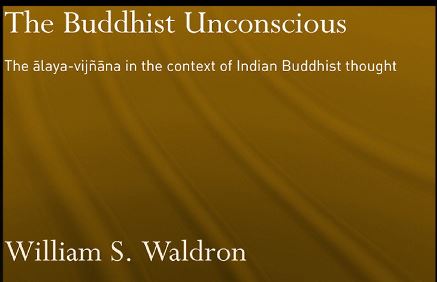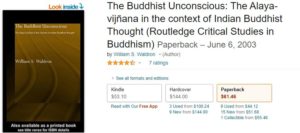
First published 2003 by Routledge Curzon, 11 New Fetter Lane, London EC4P 4EE
Simultaneously published in the USA and Canada by Routledge Curzon, 29 West 35th Street, New York, NY 10001
Routledge Curzon is an imprint of the Taylor & Francis Group
© 2003 William S. Waldron
THE BUDDHIST UNCONSCIOUS
The alaya-vijñana in the context of Indian Buddhist thought
William S. Waldron

William S. Waldron received his PhD in Buddhist Studies from the University of Wisconsin after studying extensively in India, Nepal, and Japan. Professor Waldron teaches courses on the South Asian religious traditions of Hinduism and Buddhism, Tibetan religion and history, comparative psychologies and philosophies of mind, and theory and method in the study of religion. His publications focus on the Yogacara school of Indian Buddhism and its dialogue with modern thought. Professor Waldron has been at Middlebury College since 1996. His monograph, The Buddhist Unconscious: The Ālaya-vijñāna in the Context of Indian Buddhist Thought, was published by Routledge Curzon in 2003. (Source Accessed April 15, 2020)
THE BUDDHIST UNCONSCIOUS
THEMATIC INTRODUCTION
A Buddhist critique of the construction of self and world
The Buddha offered an understanding of the actions that perpetuate the repetitive behavioral patterns called “samsara” that differed from contemporaneous Indian yogic traditions in several key respects. In the Buddhist view,1 what keeps beings trapped in these cyclic patterns is both the deep-seated but mistaken apprehension that we are (or have) an unchanging, independent, self-subsistent entity or “self ” (atman), as well as the misguided activities motivated by attachment to such a self. These activities are misguided, the Buddhists assert, because no permanent and independent individuality can actually be found in our worldly existence. Instead, sentient beings are thought to consist of aggregations of ever-evolving physiological and psychological processes which arise and persist only as long as the causes and conditions that sustain them persist. Chief amongst these sustaining conditions are, paradoxically, the very ignorance of these basic facts of life, and the futile desires and activities to deny or overcome them through attempting to grasp onto something permanent – making actions informed by ignorance and desire the “driving forces” of cyclic existence.
This view of the delusions and activities that keep beings trapped in the vicious cycle of repetitive behavior patterns was already quite clear in the early discourses of the Buddha, to which we shall return shortly. Shorn of their metaphysical dimension, however, these themes are readily understandable in modern, humanist terms, which we will briefly entertain in the next few pages.
Buddhist thought thoroughly critiques our attempts to attain permanence, independence, and self-subsistence by identifying with transient, conditioned phenomena, whether material, psychological, or conceptual. We impute intrinsic meaning and value onto these phenomena, the Buddhists assert, and imagine that their possession somehow augments our essential worth or well-being. This entails that we bifurcate our world of experience into two discrete dimensions, the objective and subjective. That is, we experience the world in terms of “objective” things – which are inevitably mediated through linguistic, cultural, and social conventions – and we imagine that they possess intrinsic power to impart happiness, health, and well-being. These “things” possess, in other words, a symbolic value above and beyond their mere physical existence. Enthralled by these enduring yet abstract objects, we create, as it were, a life-world of seemingly solid, yet unavoidably mediated “things.” Man, the symbol-making creature, constructs a world of his own in which to make his home.
But this is only half the picture. We also build up an image and an idea, and a deep-seated attachment to, an equally symbolic sense of “self” which can expe- rience and enjoy these apparently independent objects and which seems to possess equally independent, intrinsic existence. We imaginatively create a locus of subjective experience, an enduring referent to the notions of self and “I” with which we can identify and hold as our own. We imagine that we actually are an enduring subject which exists independently of the external objects around it, which it can possess and enjoy. Our entire world of experience is experienced in reference to this self-wrought self. Man, the “self-making” crea- ture, constructs the subject of his own existence which may dwell within his self-constructed home.
These parallel processes of the reification of object and subject constitute the main target of the Buddhist (and particularly the Yogacara) critique of ordinary, worldly consciousness. On the one hand, we impute the actual existence of apparently external objects, transforming them from immediate experiences into abstract objects which putatively possess inherent power and worth, constituting them within our culturally mediated, symbolic universe. On the other hand, we create an equally abstracted sense of self-identity, based upon an accumulation of experiences, memories and feelings, which possesses apparent coherence and continuity. This sense of enduring identity is the subjective counterpart of the enduring objects one apprehends and objectifies. There must be an independent “someone” in order to possess or experience a separate “something.”
Now, we must ask, how does all this come about? Why do we construct real- ity in this way, abstracting static, symbolic modes of subjective and objective experience from the on-going continuum of living processes, bifurcating them into the twin reifications of subject and object? What purposes does such creative activity serve for us as individuals, as societies, or as a species? And what drawbacks accompany these processes?
Confronted with the transiency of experience and the ever-present physical and psychological threats to our integrity and survival, organisms with higher nervous systems such as ourselves must be able to recognize and comprehend recurrent patterns underlying our variegated forms of experience, and to con- struct working models capable of anticipation, predication, and premeditation. In this sense, the emergence of a “self ” from the stream of inchoate experience into a relatively stable locus of self-reference and self-awareness, with all its regular and regulated cognitive and affective processes, is one of the most remarkable achievements of biological evolution and constitutes perhaps the most fundamental human technology.
The Buddhist critique of these twins constructions of “self ” and “world,” however, rests largely upon their deleterious consequences. We typically fail to recognize, the Buddhists contend, that the twin reifications of “self ” and “object” achieved through our linguistically and culturally mediated symbol systems are simply skillful means, highly practical tools for getting a handle on the whirlwind world within and without for the purpose of serving our own relative purposes. In our constant struggle to secure a stable, predictable, and prosperous life, we mistake these pragmatic tools and provisional purposes for actualities and ulti- mate ends: by imagining that we actually are such a self, we fail to fully appreci- ate the evolving and constructed nature of all experiential phenomena.
Hence, while our sense of self addresses one set of problems, that of coherence and continuity, it simultaneously raises another, that of our underlying anxieties bred of transience: just because it is a product of complex interactive relationships which are continuously evolving, our culturally mediated symbolic selves are also continuously slipping away, just beyond our grasp, like an optical illusion that disappears as soon as one looks straight at it. A nagging fear of our possible non-existence, a sense of the sheer fragility of this constructed “self,” is always lurking around the corner, underlying all our thoughts and actions. So we grasp all the more onto our pains, our attachments, our identities, all the while vaguely sensing that the only thing standing between us and non-existence is indeed this self-wrought self. If this were lost – or so we fear – so would be who and what we think we are. So man responds, in Ernest Becker’s terms, by building defenses; and these defenses allow him to feel a basic sense of self-worth, of meaningfulness, of power. They allow him to feel that he controls his life and his death, that he really does live and act as a willful and free individual, that he has a unique and self-fashioned identity, that he is somebody.
But this requires that we constantly reconstruct this sense of self, rehearsing our past experiences through memory and emotion and anticipating our future expe- riences through desire and imagination. We must continuously endow our “selves” with a history and a future, without which, as brain-damaged patients so poignantly illustrate, we would hardly be human. Ironically, it is our very attempt to hold onto this self-wrought self, to maintain its existential integrity, that insures our unending anxieties and insecurities, and instigates our activities to perpetuate its constructed patterns. Man, the “history-making” creature, trans- forms the raw materials of immediate experience and constructs the solidifying structures of worldly existence.
Our constructed character, our self-identity is, in other words, a vital lie, “a necessary and basic dishonesty about oneself and one’s whole situation” (ibid.: 55), Becker continues, which is constructed “for the precise purpose of putting it between [ourselves] and the facts of life” (ibid.: 59). This sense of an underlying subject of experience, however constructed, is so basic and so habitual as to occur mostly automatically, outside of our conscious awareness. This unconscious self-clinging underlies all conscious, intentional activities, insuring that our energies are constantly directed toward the continuation of the habitual thought patterns – the twin reifications of self and world – that produce and perpetuate their own frame of reference. In this respect, virtually all cultures, belief systems, and especially characters and habits, are like a comfortable web [that] keeps a person buoyed up and ignorant of himself, of the fact that he does not rest on his own center. All of us are driven to be supported in a self-forgetful way, ignorant of what energies we really draw on, of the kind of lie we have fashioned in order to live securely and serenely.
Cultures, as well as characters, can thus be seen as symbolic wish-fulfillments: if we cannot get what we really want – actual individual, autonomous existence – then we substitute symbols for realities and achieve our aims by surrogates means. Rather than facing the facts of impermanence and insecurity and accepting the transient and contingent nature of our lives, we attempt to avoid awareness of them by constructing enduring symbols of wealth and meaning, of life and pleasure, in reference to which our putative permanent selves exist as equally undying, and hence inevitably lifeless, subjects. If things themselves have no sustainable existence, then at least their consensually mediated symbols do. If our life itself has no apparent permanency, then at least the abstract symbol of “self ” that stands for it does. We live, that is, as in a symbolic world constructed by our own imaginative powers. We are always actively, albeit unconsciously, ignoring the radically interdependent nature of our existence and setting up in its place the “false idol” of a self, the undying and therefore unliving symbol that represents our unrequited desires for permanent, personal autonomous existence.
This is, of course, no deliberate course of action. It is merely the extension of those deeply embedded cognitive and affective capacities that have otherwise proved so conducive to human survival. This is the tragic vision common to so many cultural and religious traditions. It is our very success that plagues us, for, as Becker avers, these are necessary and vital lies, providing necessary skills and serving vital, albeit worldly, interests.4 But lies they are, clothing the world in fabricated illusions, interpreting all experience in reference to our own constructed self-view. We are as drunk with our own god-like powers of self-and world-creation, inebriated by a hubris which dares to call itself homo sapiens, the wise one. We have, in this way, bound the bonds of our own bounded, worldly existence.
* * *
These themes, so clearly and incisively expressed in various streams of modern thought, are strikingly similar to the ideas discussed in these pages, and we shall return to them again and again in their Buddhist guise. Indeed, they suggest an initial working glossary of the core concepts used throughout this text:
![]() klihia-manas, “afflictive mentation,” unconscious self-grasping which occurs in every moment of worldly existence, which is itself informed by:
klihia-manas, “afflictive mentation,” unconscious self-grasping which occurs in every moment of worldly existence, which is itself informed by:![]() kleka, the afflictive cognitive and emotional attitudes that color most of our
kleka, the afflictive cognitive and emotional attitudes that color most of our
activities, in particular:![]() the conceit “I am” (asmimana);
the conceit “I am” (asmimana);![]() the view of self-existence (satkayadghii);
the view of self-existence (satkayadghii);![]() attachment to self (atmasneha);
attachment to self (atmasneha);![]() ignorance (avidya). Activities instigated by these give rise to:
ignorance (avidya). Activities instigated by these give rise to:![]() sadskara, karmic formations, the constructed physiological and psychological structures which have been built up by past activities and reinforce their own reoccurrence, and which, in some contexts, also refers to those very activities themselves. These are often accompanied by:
sadskara, karmic formations, the constructed physiological and psychological structures which have been built up by past activities and reinforce their own reoccurrence, and which, in some contexts, also refers to those very activities themselves. These are often accompanied by:![]() upadana, appropriation or grasping, the process of taking the body, thoughts,
upadana, appropriation or grasping, the process of taking the body, thoughts,
or feelings as one’s own, as well as the “objects” so taken. And these under- lie or support the arising of:![]() vijñana, consciousness or cognitive awareness, which gives rise to our common world of reified “subjects” and “objects” – which in turn instigate the afflictions leading to further activities that reinforce the whole process, creating the vicious circle called “samsara.”
vijñana, consciousness or cognitive awareness, which gives rise to our common world of reified “subjects” and “objects” – which in turn instigate the afflictions leading to further activities that reinforce the whole process, creating the vicious circle called “samsara.”
In contrast with modern humanistic approaches, however, Indian religious systems consider that the processes of creating our “selves” and our “world” – the bifurcation of experience into subject and object – entail actual cosmogonic (cosmos creating) or ontological consequences. As Lama Govinda explains, in the Buddhist world-view
It is on account of our clinging to these forms of life that again and again we produce them. … It is our will, our ardent desire which creates the world in which we live, and the organism which corresponds to it.
(Govinda, 1969: 54)
This book is an extended examination of these processes and the consequences they set in motion, centering on the Yogacara concept of the alaya-vijñana, the subliminal “base, store, or home” consciousness, which is always accompanied by an unconscious apprehension of self. The alaya-vijñana primarily represents this persisting locus of habituated yet unconscious reifications of self and world and hence constitutes the main obstacle to liberation from the bonds of cyclic existence. Like the other yogic traditions developed in classical Gupta-era India, as Eliade described them, the Yogacara thinkers discovered that “the great obstacles to the ascetic and contemplative life arose from the activity of the unconscious, from the sadskaras and the vasanas – ‘impregnations,’ ‘residues,’ ‘latencies’ – that constitute what depth psychology calls the contents and structures of the unconscious” (Eliade, 1973: p. xvii). Although we will not discuss at any length either the practices toward or the results of liberation from these obstacles, our examination of the alaya-vijñana will at least clarify exactly what, in the Yogacara view, one is to be liberated from: the dynamic cognitive and behavioral patterns perpetuating the vicious cycle of repetitive behavioral patterns called samsara.
In order to understand the historical developments through which the alaya- vijñana came to represent these habitual behavioral patterns, however, we must first examine these ideas as expressed in the early discourses of the Buddha. We will find here, in incipient form, nearly all of the basic elements that would later comprise the Yogacara model of unconscious mind, the alaya-vijñana. This topic is addressed in our first chapter.
